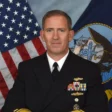Insight by EY
Rigid, linear supply chains must be a thing of the past for agencies
Retired Navy Rear Adm. John Polowczyk, executive director of EY, said agencies must strive for end-to-end visibility as part of becoming more predictive in managing...
One of the biggest lesson learned by agencies and the private sector alike over the last three years when it comes to managing their supply chains is it comes down to a simple formula.
Resiliency equals visibility plus agility (R=V+A) so says retired Navy Rear Adm. John Polowczyk, executive director at EY, an engineer by training.
“The beginning piece here is end-to-end visibility as a way to monitor the risk of your supply chain,” Polowczyk said on the discussion Government Modernization Unleashed: Supply Chain. “The old adage you have to be able to see a supply chain to manage it. Understanding that the ability to do what if scenarios, the ability to have some artificial intelligence and forecasting in there is a central piece of it. People are also taking a step back and saying, ‘what does my supply chain look like? How do I make it an agile network?’ The lesson learned from the pandemic, those linear systems really broke.”
The healthcare supply chain felt the brunt of the broken linear systems.
Polowcyzk, who was the White House Supply Chain lead on the Coronavirus Task Force from March 2020 to November 2020, saw firsthand how rigid healthcare supply chains struggled during the first year of the pandemic.
“People today are understanding that they need to rethink their operating models. They need alternate sources of supply. I don’t care what industry you’re in, you’re going to have a disruption. It sounds simple, but it’s really hard work to diversify your sources,” he said. “I think people are now starting to see a networked diversified ecosystem. I think in health care, they’re really starting to understand they need end-to-end visibility. They’ve got to get deeper into supplier management.”
Know your data
Of course the first step toward that end-to-end visibility to create deeper supplier management is data.
Agencies and private sector organizations need to understand what data they have, where it lives and how they can use it do to things like demand forecasting.
“The first thing that you have to do is get what I would call a master data strategy. It’s a way to get a handle on what you have today,” Polowcyzk said. “If we had harnessed the data we had today and made it visible in a structure, that question of what equipment we had and where wouldn’t have taken a lot to answer. Really, the next is how do use that data strategy to create self-healing data models or data strategies to drive your predictive efforts.”
Polowcyzk said agencies can do that through commercial applications that provide tools to better manage data, including the use of advanced analytics like AI and machine learning.
“There are three areas in any kind of modernization to drive outcomes for practitioners and patients. You have to reshape the end-to-end supply chain from disparate manual processes or disparate systems to create a globally digitally enabled enterprise,” he said. “You have got to take these disparate systems and make sense of them. I think they have got to shift the utilization or the data that they have, from a backward looking mechanism or metrics to real-time reporting in the cloud. This will let them implement predictive tools. We see supply chains becoming autonomous at some point in the future.”
Improving user experience
The real goal in all of this is to reduce the complexity of managing supply chains and making it easier for the doctors, nurses and healthcare practioners to know what equipment they have one hand today and what they will need in the next day, week or month.
Polowcyzk said moving toward a real-time, predictive supply chain management is already happening in some sectors. He is working with one federal agency on predictive maintenance where they are predicting when failures are going to happen with 80% accuracy.
“I think everybody is realizing that supply chains and logistics are really important. We’ve had a period of time where we could be sloppy with it or we could not manage it. But I see the time now that the supply chain, the chief supply chain officer is in the C-suite, making helping make the right decisions,” he said. “I see that there are multiple levels. You do need that very strong senior advocate, and then I think the supply chain and logistics considerations are then threaded through all levels of the command or the company or the health care network. I think everybody has to understand and be a part of it. It cannot just be my procurement people are buying stuff. That’s gone. I think people realized that they’ve got to get in to understand what are their supply chains doing and how are their supply chains either supporting them or not supporting them.”
For more on on the Government Modernization Unleashed series, click here.
Listen to the full show:
Copyright © 2025 Federal News Network. All rights reserved. This website is not intended for users located within the European Economic Area.
Featured speakers
-

Retired Rear Adm. John Polowczyk (Navy)
Executive Director, EY
-

Jason Miller
Executive Editor, Federal News Network
Upcoming Events
Top Stories

Retired Rear Adm. John Polowczyk (Navy)
Executive Director, EY

Jason Miller
Executive Editor, Federal News Network
Jason Miller has been executive editor of Federal News Network since 2008. Jason directs the news coverage on all federal issues. He has also produced several news series – among them on whistleblower retaliation at the SBA, the overall impact of President Obama’s first term, cross-agency priority goals, shared services and procurement reform.



